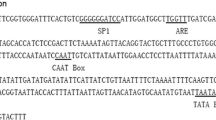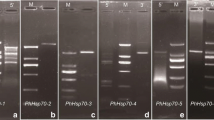Abstract
The nuclear heat shock geneHSP70B ofChlamydomonas reinhardtii is inducible by heat stress and light. Induction by either environmental cue resulted in a transient elevation in HSP70B protein. Here we describe the organization and nucleotide sequence of theHSP70B gene. The deduced protein exhibits a distinctly higher homology to prokaryotic HSP70s than to those of eukaryotes, including the cytosolic HSP70A ofChlamydomonas reinhardtii. The HSP70B protein, as previously demonstrated by in vitro translation, is synthesized with a cleavable presequence. Using an HSP70B-specific antibody, this heat shock protein was localized to the chloroplast by cell fractionation experiments. A stromal location was suggested by the presence of a conserved sequence motif used for cleavage of presequences by a signal peptidase of the stroma. Amino acid alignments of HSP70 proteins from various organisms and different cellular compartments allowed the identification of sequence motifs, which are diagnostic for HSP70s of chloroplasts and cyanobacteria.
Similar content being viewed by others
References
Amir-Shapira D, Leustek T, Dalie B, Weissbach H, Brot N: Hsp70 proteins, similar toEscherichia coli DnaK, in chloroplasts and mitochondria ofEuglena gracilis. Proc Natl Acad Sci USA 87: 1749–1752 (1990).
Bloch MA, Johnson KA: Identification of a molecular chaperone in the eukaryotic flagellum and its localization to the site of microtubule assembly. J Cell Sci 108: 3541–3545 (1995).
Bradwell JCA, Craig EA: Major heat shock genes ofDrosophila and theEscherichia coli heat-induciblednak gene are homologous. Proc Natl Acad Sci USA 81: 848–852 (1984).
Chitnis PR, Nelson N: Molecular cloning of the genes encoding two chaperone proteins of the cyanobacteriumSynechocystis sp.PCC6803. J Biol Chem 266: 58–65 (1991).
Chua N-H, Bennoun P: Thylakoid membrane polypeptides ofChlamydomonas reinhardtii: wild-type and mutant strains deficient in photosystem II reaction center. Proc Natl Acad Sci USA 72: 2175–2179 (1975).
Craig EA, Kramer J, Shilling J, Werner-Washburne M, Holmes S, Kosic-Smithers J, Nicolet C-M:SSCI, an essential member of the yeastHSP70 multigene family, encodes a mitochondrial protein. Mol Cell Biol 9: 3000–3008 (1989).
Davies DR, Plaskitt A: Genetical and structural analyses of cell-wall formation inChlamydomonas reinhardtii. Genet Res 17: 33–43 (1971).
Engman D, Kirchhoff LV, Donelson JE: Molecular cloning ofmtp70, a mitochondrial member of thehsp70 family. Mol Cell Biol 9: 5163–5168 (1989).
Franzén L-G, Rochaix J-D, vonHeijne G: Chloroplast transit peptides from the green algaChlamydomonas reinhardtii share features with both mitochondrial and higher plant chloroplast presequences. FEBS Lett 260: 165–168 (1990).
Freeman BC, Myers MP, Schuhmacher R, Morimoto R: Identification of a regulatory motif in Hsp70 that affects ATPase activity, substrat binding and interaction with HDJ-1. EMBO J 14: 2281–2292 (1995).
Frohman MA, Dush MK, Martin GR: Rapid production of full-length cDNAs from rare transcripts: Amplification using a single gene-specific oligonucleotide primer: Proc Natl Acad Sci USA 85: 8998–9002 (1988).
Gomes SL, Gober JW, Shapiro L: Expression of theCaulobacter heat shock genednak is developmental controlled during growth at normal temperature. J Bact 172: 3051–3059 (1990).
Harris E: TheChlamydomonas Sourcebook. Academic Press, San Diego, USA (1989).
Higgens DG, Bleasby AJ, Fuchs R: CLUSTAL V: Important software for multiple sequence alignments. CABIOS 8: 189–191 (1992).
Klein U, Chen C, Gibbs M, Platt-Aloia KA: Cellular fractionation ofChlamydomonas reinhardtii with emphasis on the isolation of the chloroplast. Plant Physiol 72: 481–487 (1983).
Kozak M: Compilation and analysis of sequences upstream from the translational start site in eukaryotic mRNAs. Nucl Acids Res 12: 857–872 (1984).
Kropat J, vonGromoff ED, Müller FW, Beck CF: Heat-shock and light activation ofChlamydomonas HSP70 gene are mediated by independent regulatory pathways. Mol Gen Genet 248: 727–734 (1995).
Loh EY, Elliott JF, Cwirla S, Lanier LL, Davis MM: Polymerase chain reaction with single-sided specificity: analysis of T cell receptor δ chain. Science 243: 217–220 (1989).
Marshall JS, DeRocher AE, Keegstra K, Vierling E: Identification of heat-shock protein hsp70 homologues in chloroplasts. Proc Natl Acad Sci USA 87: 374–378 (1990).
Marshall JS, Keegstra K: Isolation and characterization of a cDNA clone encoding the major Hsp70 of the pea chloroplastic stroma. Plant Physiol 100: 1048–1054 (1992).
McKay DB: Structure and mechanism of 70-kDa heat-shock related proteins. Adv Prot Chem 44: 67–98 (1993).
Müller FW, Igloi GL, Beck CF: Structure of a gene encoding heat-shock protein HSP70 from the unicellular algaChlamydomonas reinhardtii. Gene 111: 165–173 (1992).
Munro S, Pelham HR: An Hsp70-like protein in the ER: identity with the 78 kDa glucose-regulated protein and immunoglobulin heavy chain binding protein. Cell 46: 291–300 (1986).
Neumann D, Nover L, Parthier B, Rieger R, Scharf KD, Wollgiehn R, zurNieden U: Heat-shock and other stress response systems of plants. Biol Zentralbl 108: 1–155 (1989).
Neumann D, Emmermann M, Thierfelder JM, zurNieden U, Clericus M, Braun H-P, Nover L, Schmitz UK: HSP68: a DnaK-like heat-stress protein of plant mitochondria. Planta 190: 32–43 (1993).
Reith M, Munholland J: An hsp70 homolog is encoded on the plastid genome of the red alga,Porphyra umbilicalis. FEBS Lett 294: 116–120 (1991).
Rensing SA, Maier UG: Phylogenetic analysis of the stress-70 protein family. J MOl Evol 39: 80–86 (1994).
Roberts JK, Key JL: Isolation and characterization of a soybeanhsp70 gene. Plant Mol Biol 16: 671–683 (1991).
Rose MD, Misra LM, Vogel JP: KAR2, a karyogamy gene, is the yeast homolog of the mammalian BiP/GRP78 gene. Cell 57: 1211–1221 (1989).
Sanger F, Nicklen S, Coulson AR: DNA sequencing with chainterminating inhibitors. Proc Natl Acad Sci USA 74: 5463–5467 (1977).
Scaramuzzi CD, Stokes HW, Hiller RG: Heat-shock Hsp70 protein is chloroplast-encoded in the chromophytic algaPavlova lutherii. Plant Mol Biol 18: 467–476 (1992).
Ting J, Lee AS: Human gene encoding the 78000-dalton glucose-regulated protein and its pseudogene: Structure, conservation and regulation. DNA 7: 275–286 (1988).
Treier U, Fuchs S, Weber M, Wakarchuk WW, Beck CF: Gametic differentiation inChlamydomonas reinhardtii: light dependence and gene expression patterns. Arch Microbiol 152: 572–577 (1989).
Vierling E: The roles of heat-shock protein in plants. Annu Rev Plant Physiol Plant Mol Biol 42: 579–620 (1991).
vonGromoff ED, Treier U, Beck CF: Three light-inducible heat-shock genes ofChlamydomonas reinhardtii. Mol Cell Biol 9: 3911–3918 (1989).
vonHeijne G, Stepphun J, Herrmann G: Domain structure of mitochondrial and chloroplast targetting peptides. Eur J Biochem 180: 535–545 (1989).
Waegemann K, Soll J: Characterization of the protein import apparatus in isolated outer envelopes of chloroplasts. Plant J 1: 149–158 (1991).
Wang H, Goffreda M, Leutstek T: Characteristics of an Hsp70 homolog localized in higher plant chloroplasts that is similar to DnaK, the Hsp70 of prokaryotes. Plant Physiol 102: 843–850 (1993).
Wang S, Liu X-Q: The plastid genome ofCryptomonas ϕ encodes an hsp70-like protein, a histone-like protein, and an acyl carrier protein. Proc Natl Acad Sci USA 88: 10783–10789 (1991).
Watts FZ, Walters AJ, Moore AL: Characterization of PHSP1, a cDNA encoding a mitochondrialhsp70 gene fromPisum sativum. Plant Mol Biol 18: 23–32 (1992).
Welch W, Feramisco JR: Rapid purification of mammalian 70,000-dalton stress proteins: affinity of the proteins for nucleotides. Mol Cell Biol 5: 1229–1237 (1985).
Winter J, Wright R, Duck N, Gasser C, Fraley R, Shah D: The inhibition of petuniahsp70 mRNA processing during CdCl2 stress. Mol Gen Genet 211: 315–319 (1988).
Author information
Authors and Affiliations
Rights and permissions
About this article
Cite this article
Drzymalla, C., Schroda, M. & Beck, C.F. Light-inducible geneHSP70B encodes a chloroplast-localized heat shock protein inChlamydomonas reinhardtii . Plant Mol Biol 31, 1185–1194 (1996). https://doi.org/10.1007/BF00040835
Received:
Accepted:
Issue Date:
DOI: https://doi.org/10.1007/BF00040835




